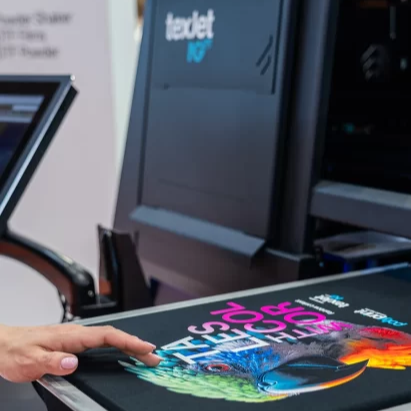Textile printing has undergone a significant evolution over the years, offering a diverse range of methods to transfer designs onto fabrics. Among the main contemporary techniques, DTG (Direct to Garment), DTF (Direct to Film) and screen printing stand out for their unique approaches , distinct advantages and specific application areas .
DTG (Direct to Garment)
DTG is a modern printing method that is similar to inkjet printing. It involves printing directly onto textiles , applying the ink directly onto the garment. This technique offers significant advantages:DTG Strengths:
- Design Versatility : Ideal for intricate designs, color gradients and detailed patterns.
- Low Costs for Small Series : Cost-effective for small production quantities.
- Less Preparation Time : Less preparation required compared to other techniques.
- Fabric Limitations : Works best on cotton or cotton-based fabrics.
- High Costs for Large Series : Can become expensive for mass production.
- Required Maintenance : DTG printers require regular maintenance to maintain their performance.
The DTG printer brands we distribute, Kornit and Polyprint , are major references in the field of direct textile printing.
Kornit, with its well established reputation, offers high quality machines renowned for their exceptional performance , colour accuracy and ability to handle a wide range of fabrics.
For its part, Polyprint stands out for its innovative approach and commitment to ease of use , offering versatile and user-friendly DTG solutions, perfect for small and medium-sized businesses looking to get started in the textile printing field.
By distributing these renowned brands, we ensure our customers have access to cutting-edge technologies and reliable solutions to meet their DTG printing needs with confidence and success .
DTF (Direct to Film)
DTF involves using a special film to transfer the image onto the textile. This film is printed with a special printer, then heated and pressed onto the fabric to create the design. Here are the key aspects:DTF Strengths:
- Adaptability to Various Fabrics : Can be used on a wide variety of fabrics, including polyester.
- Competitive Cost for Small and Medium Series : Cost-effective for moderate production quantities.
- Vibrant Color Results : Delivers vivid, vibrant colors.
- Complex Designs Limitation : Less suitable for fine details and color gradients.
- Two-Step Process : Requires printing the film and then transferring it to the textile, which can lengthen the production process.
- Limited Durability : May have less durability compared to other printing methods.
STS Inks, as a renowned American brand in the field of printers and consumables, embodies excellence and innovation in the printing industry. Their reputation is based on their deep expertise in formulating premium inks suitable for a diverse range of printing applications. In addition to offering premium inks , STS Inks has also engaged in the design and manufacturing of specialty printers , thus offering complete solutions for direct-to-film (DTF) printing needs. Their commitment to innovation, product reliability and compatibility with the brand’s inks makes STS Inks printers a trusted choice for companies looking to optimize their textile printing production . By distributing STS Inks printers and consumables, we offer our customers access to cutting-edge technology and complete solutions , ensuring exceptional results and long-term satisfaction .
Screen printing
Screen printing is a traditional technique that involves the use of screens to transfer ink onto fabric . This method has its own strengths:Strengths of Screen Printing:
- High Durability : Provides excellent durability, ideal for long-term printing.
- Cost-effective for Large Series : Becomes more economical as production quantity increases.
- Fabric Versatility : Works well on a variety of fabrics including cotton, polyester and even metal and wood.
- Design Complexity : Less suitable for complex patterns and color gradients.
- High Initial Costs : Initial costs for creating screens may be higher.
The MHM and Walz brands represent excellence in screen printing equipment, offering innovative and high-quality solutions for professionals in the textile industry. Their screen printing carousels are renowned for their robustness , precision and ability to meet the requirements of the most demanding production environments.
MHM carousels are distinguished by their advanced engineering , providing maximum automation and efficiency in the screen printing process, while Walz equipment focuses on versatility , build quality and ease of use to meet the varied needs of printers.
By distributing screen printing carousels from these renowned brands, we provide our customers with access to reliable and high-performance equipment , thereby strengthening their ability to produce high-quality prints with optimum efficiency.
Recommended Usage Scenarios
DTG : Ideal for intricate designs requiring detailed printing on cotton fabrics.DTF : Perfect for simple to moderately complex designs on a variety of fabrics , including polyester, at a competitive cost for moderate production runs.
Screen Printing : Recommended for large-scale productions requiring durable prints on various types of fabrics, despite higher initial costs.
In conclusion, the choice between DTG, DTF, and screen printing largely depends on the specific needs in terms of design, production quantity, fabric types, and desired durability. Each technique brings its own unique set of benefits and considerations, offering textile printing professionals a diverse range of options to meet a multitude of needs.

